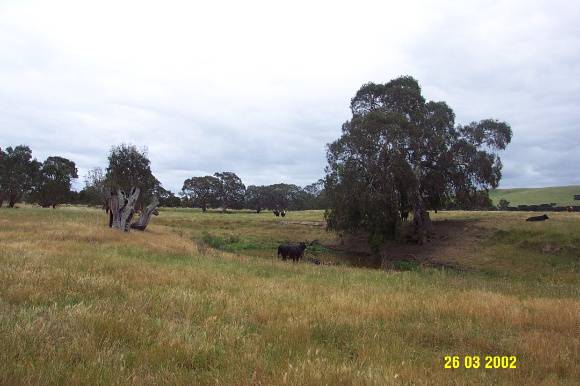| Back to search results » | Back to search page » |
|
KOROITE HOMESTEAD (ORIGINAL SITE) & BUVELOT TREE
Locationoff Glenelg Highway COLERAINE, Southern Grampians Shire
File Number1662LevelStage 2 study complete |
|
Statement of Significance
What is significant?
The original site of the Koroite Homestead complex, as part of the Koroite squatting run and the water pool and trees depicted in Louis Buvelot's 'Waterpool at Coleraine' are both located in the same area. This site is located 1.75 kilometers north east of the township of Coleraine, on the north side of Bryants creek, about 800 metres to the south behind the Coleraine Showgrounds Reserve. These sites were both once included in the original Korotie Station's Pre-emptive right (P.B 299). The Koroite run originally a part of the Whyte Brothers huge run, Konongwootong. In 1845, Konongwootong underwent a division, and one of the Whyte Brothers (C.J Whyte) took ownership of 8000 acres of land, based 1 mile north east of the Coleraine township, and named it Koroite. Between 1850 and 1870 the station went through a variety of owners, including Stephen George Henty (of the Henty Brothers) and finally being purchased in 1870 by William Swan. It was around 1871 when Louis Buvelot, the famous landscape painter visited the Coleraine district on a painting expedition. While in the area, he painted William Swan's Homestead, Konongwootong, and also painted 'Waterpool at Coleraine', on land owned by Swan. There is no surviving evidence of the once substantial homestead complex which is evident from an 1855 survey by the Department of Lands and Survey, although there may be archaeological potential. The elements of the homestead complex, including a homestead (said to have been wattle and daub), a woolshed, garden, sheepwash, hut, ford, fences and tracks covered about one hectare. The Buvelot scene, including the waterhole and Eucalyptus camadulensis (River Red Gums) has survived, and is recognisable, although the trees are in poor condition and the waterpool has been damaged by cattle.
How is it significant?
The site of the former Koroite Homestead complex is of historic and archaeological significance to the township of Coleraine and the Southern Grampians Shire as a Heritage Inventory Site. The site of the scene depicted in Louis Buvelot's 'Waterpool at Coleraine' is of aesthetic and cultural significance to the Southern Grampians Shire as a Significant Landscape
Why is it significant?
The site of the original Koroite Homestead is of historical significance for its associations with important early local pastoralists, including C.J Whyte, Stephen George Henty and William Swan. It is historically important as one of the earliest runs in the district, and for its location, strategically situated close to the township of Coleraine. It is a representative example of how early pastoral homestead complexes thrived and declined, in that by 1855 it was a fully functioning homestead complex with a variety of elements, yet by 1886 the last surviving element (a wattle and daub homestead) blew down in a strong gale. It is of archaeological significance for the information it may reveal about the ways in which early pastoralists lived and construction materials and techniques of their buildings.
The surviving elements of the scene depicted in Louis Buvelot's 1871 painting, 'Waterpool at Coleraine' is aesthetically important to the State of Victoria as a rare surviving example of what an artist depicted in the 1870s. It is aesthetically important as an example of landscape tradition which was used by Buvelot, and went on to influence many of Australia's famous artists from the Heidelberg School.
Group
Farming and Grazing
Category
Homestead Complex





